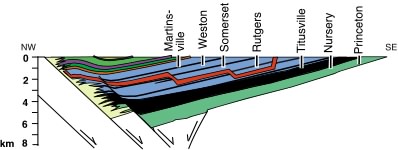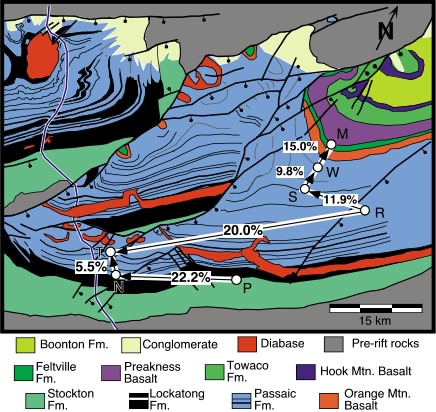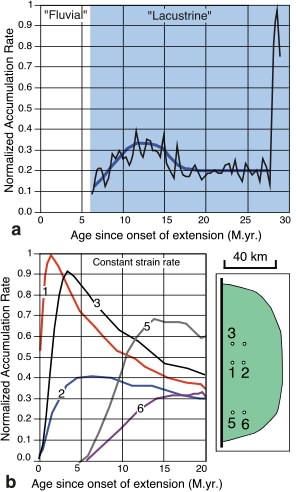
| Previous |
3.3. Tectonics of Rifting and Drifting: Pangea Breakup
3.3.2. Extracting Tectonic Information from Cores in Rift Basins
Roy W. Schlische
Department of Geological Sciences, Rutgers University, Piscataway,
NJ 08854-8066 U.S.A.
Rift basins are tectonic features. Thus, a goal of any
large-scale study involving rift basins should be a better understanding
of the tectonic processes controlling basin formation and infilling. The
NSF-funded Newark Basin Coring Project (NBCP) demonstrated that it is possible
to extract tectonic information from cores in rift basins. This section
reviews the successes of NBCP in terms of tectonics and basin evolution
and briefly highlights some of the unanswered questions.
 |
Figure 3.3.3.1. Schematic cross section of the Newark basin showing offset coring technique; marker unit at the base of one core correlates with same marker unit at top of adjacent core. From Schlische (2000). |
NBCP used an offset drilling technique (e.g., Olsen et
al., 1996a) to take advantage of the eroded half-graben geology of the
Newark basin. Core sites were positioned so that the bottom of one hole
overlapped with the top of an adjacent hole in a distinctive stratigraphic
interval (Figure 3.3.2.1). Correlations are based on cyclostratigraphy
and magnetostratigraphy (Olsen et al., 1996a; Kent et al., 1995). The overlap
sections allowed construction of a composite stratigraphic section (Olsen
et al., 1996a; section 3.2.2). In addition, the overlap sections by themselves
provide useful tectonic information. For example, the overlap section between
the Rutgers and Somerset cores shows that stratigraphic units thicken by
~12% across the 10 km between these holes (Figure 3.3.2.2). In addition,
lake facies are deeper in Somerset than Rutgers. All overlap sections
thicken from the lateral edge of the basin toward the basin center (e.g.,
Rutgers-Titusville) and from the hinged margin toward the intrabasinal
faults and/or border fault system (e.g., Nursery-Titusville) (Figure 3.3.2.3).
The simplest interpretation of these variations in thickness and facies
is variations in basin subsidence caused by syndepositional faulting (see
Figure 3.3.2.1).
 |
Figure 3.3.3.3. Geologic map of the north-central part of the Newark basin showing the locations of the seven NBCP drill sites. Arrows indicate the amount of thickening between overlap sections of stratigraphically adjacent cores based on correlations in Olsen et al. (1996a). Abbreviations for drill holes are: M, Martinsville; N, Nursery; P, Princeton; R, Rutgers; S, Somerset; T, Titusville; W, Weston. From Schlische (2000). |
Correlations of the NBCP cored sections to outcrop sections
is also extremely useful (e.g., Silvestri, 1994, 1997; Olsen et al., 1996a;
Schlische, 1999). The Perkasie Member of the Passaic Formation extends
across 125 km of the Newark basin (Figure 3.3.2.4). Variations in thickness
of the Perkasie Member indicate that the Newark basin is a large longitudinal
syncline, consistent with border-fault displacement being highest near
its center and declining towards its lateral ends (e.g., Schlische, 1992)
(also see Figure 3.3.2.1). Additional core-to-outcrop correlations, coupled
with seismic-reflection profiles, indicate that a hierarchy of fault-related
folds along the border fault system and intrabasinal faults formed, at
least in part, syndepositionally (Jones, 1994; Schlische, 1992, 1995; Reynolds,
1994; Olsen et al., 1996).
The large-scale basin geometry outlined above, the large-scale
stratigraphic architecture present in the NBCP composite section (see Figures
2.4 and 3.3.1.5), and onlap relationships revealed by seismic data can
be reproduced in quantitative basin-filling models (see Figure 3.3.1.3).
Although these basin-filling models successfully explain many aspects of
the stratigraphy of the Newark basin and many other non-marine rift basins
(e.g., Lambiase, 1990; Schlische and Olsen, 1990; Olsen, 1997), this simply
indicates that the models are viable. The models are bolstered because
they also make quantitative predictions about accumulation rates. In the
Newark basin, accumulation rates are derived from Milankovitch lacustrine
cycles in the NBCP composite section (Figure 3.3.2.5a; Contreras et al.,
1997; Olsen and Kent, 1999). The most sophisticated numerical basin filling
models (which incorporate self-similar faulting, flexure, isostasy, and
sediment diffusion; Contreras et al., 1997) broadly account for observed
trends in accumulation rates in the NBCP data (Figure 3.3.2.5b). In addition,
the basin-filling models place constraints on the boundary conditions of
the rifting process (constant strain-rate conditions are favored over constant
fault-lengthening rate), the rheology of the crust and lithosphere, and
the nature of fault growth (Schlische, 1991; Schlische and Anders, 1996;
Contreras et al., 1997).
 |
Figure 3.3.3.5. Accumulation rate data derived from NBCP cyclostratigraphy (a) and constant strain-rate basin-filling model (b). The two accumulation rate data sets were normalized by the maximum accumulation rate in each data set to facilitate comparisons. The numbered curves in (b) were derived from vertical drill holes through the model rift basin shown in map view on right. Curve 2 fits the Newark basin data reasonably well, but fails to reproduce the marked increase in accumulation rates at ~27.5 M.yr. since the onset of extension (Early Jurassic extrusive interval). Modified from Olsen (1997), Contreras et al. (1997), and Schlische (2000). |
Deviations from the predictions of the models are also
important. The most notable deviation in the Newark basin concerns the
markedly higher accumulation rates (Figure 3.3.2.5) and deeper lake facies
present in the Early Jurassic strata (tectonostratigraphic (TS) package
IV; see Figure 3.3.1.5) compared with those in TS-III (Olsen et al., 1996a,
b). Strata belonging to TS-IV are interbedded with a series of lava flows
(CAMP flows) that were emplaced in as little as 650 kyr (Olsen et al.,
1996b). Schlische and Olsen (1990) postulated that accelerated faulting
and tilting would markedly increase basin asymmetry. This would cause sediments
and water to shift toward the basin depocenter, increasing accumulation
rates and average lake depths. This anomaly is not just limited to the
Newark basin: a plot of cumulative stratigraphic thickness versus age (Figure
3.3.2.6) shows marked increases in accumulation rates for all of the eastern
North American rifts containing Early Jurassic strata (Schlische and Anders,
1996). Thus, tectonics is likely responsible for this "anomaly", although
the relationship of CAMP volcanism to this tectonic anomaly is not clear.
 |
Figure 3.3.3.6. Cumulative stratigraphic thickness versus geologic age for various exposed rift basins in eastern North America. The Culpeper (C), Deerfield (D), Fundy (F), Hartford (H), and Newark (N) basins all show pronounced increases in stratal thickness in earliest Jurassic time (extrusive interval). Other abbreviations are DR, Deep River; DV, Danville; and R, Richmond basins. Modified from Schlische and Anders (1996). |
References:
Contreras, J., Scholz, C.H., King, G.C.P., 1997, A general model of rift basin evolution: constraints of first order stratigraphic observations: Journal of Geophysical Research, v. 102, p. 7673-7690.
Jones, B.D., 1994, Structure and stratigraphy of the Hopewell fault block, New Jersey and Pennsylvania: M.S. Thesis, New Bruswick, NJ, Rutgers University.
Kent, D.V., Olsen, P.E., and Witte, W.K., 1995, Late Triassic-earliest Jurassic polarity sequence and paleolatitudes from drill cores in the Newark rift basin, eastern North America: Journal of Geophysical Research, v. 100, p. 14,965-14,998.
Lambiase, J.J., 1990, A model for tectonic control of lacustrine stratigraphic sequences in continental rift basins, in Katz, B.J., ed., Lacustrine Exploration: Case Studies and Modern Analogues: AAPG Memoir 50, p. 265-276.
Olsen, P.E., 1997, Stratigraphic record of the early Mesozoic breakup of Pangea in the Laurasia-Gondwana rift system: Annual Reviews of Earth and Planetary Science, v. 25, p. 337-401.
Olsen, P.E. and D.V. Kent, 1999, Long-period Milankovitch cycles from the Late Triassic and Early Jurassic of eastern North America and their implications for the calibration of the early Mesozoic time scale and the long-term behavior of the planets: Transactions of the Royal Society of London, series A, in press.
Olsen, P.E., Kent, D.V., Cornet, B., Witte, W.K., and Schlische, R.W., 1996a, High-resolution stratigraphy of the Newark rift basin (early Mesozoic, eastern North America): Geological Society of America Bulletin, v. 108, p. 40-77.
Olsen, P.E., Schlische, R.W., and Fedosh, M.S., 1996b, 580 kyr duration of the Early Jurassic flood basalt event in eastern North America estimated using Milankovitch cyclostratigraphy, in Morales, M., ed., The Continental Jurassic: Museum of Northern Arizona Bulletin 60, p. 11-22.
Reynolds, D.J., 1994, Sedimentary basin evolution: tectonic and climatic interaction: Ph.D. thesis, New York, Columbia University.
Schlische, R.W., 1991, Half-graben filling models: new constraints on continental extensional basin development: Basin Research, v. 3, p. 123-141.
Schlische, R.W., 1992, Structural and stratigraphic development of the Newark extensional basin, eastern North America; Implications for the growth of the basin and its bounding structures: Geological Society of America Bulletin, v. 104, p. 1246-1263.
Schlische, R.W., 1995, Geometry and origin of fault-related folds in extensional settings: AAPG Bulletin, v. 79, p. 1661-1678.
Schlische, R.W., 1999, Progress in understanding the structural geology, basin evolution, and tectonic history of the eastern North American rift system, in LeTourneau, P.M., and Olsen, P.E., eds., Aspects of Triassic-Jurassic Rift Basin Geoscience: New York, Columbia University Press, in press.
Schlische, R.W., and Anders, M.H., 1996, Stratigraphic effects and tectonic implications of the growth of normal faults and extensional basins, in Beratan, K.K., ed., Reconstructing the Structural History of Basin and Range Extension Using Sedimentology and Stratigraphy: GSA Special Paper 303, p. 183-203.
Schlische, R.W., and Olsen, P.E., 1990, Quantitative filling model for continental extensional basins with applications to early Mesozoic rifts of eastern North America: Journal of Geology, v. 98, p. 135-155.
Silvestri, S.M., 1994, Facies analysis of Newark basin cores and outcrops: Geological Society of America Abstracts with Programs, v. 26, p. A-402.
Silvestri, S.M., 1997, Cycle correlation, thickening trends, and facies
changes of individual paleolake highstands across the Newark basin, New
Jersey and Pennsylvania: Geological Society of America Abstracts with Programs,
v. 29, p. 80.
| Previous |